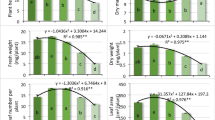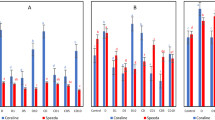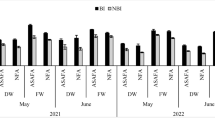Abstract
IN experiments with Chrysanthemum morifolium1 plants treated with (2-chloroethyl) trimethyl ammonium chloride (‘CCC’) and Petunia hybrida2 plants treated with 2,4-di-chlorobenzyltributyl phosphoniura chloride (‘Phosfon’) it has been observed that treated plants seemed to be less susceptible to water stress than untreated ones. High temperatures following periods of low light intensities caused wilting in control plants, while treated plants remained turgid. These substances are growth-retarding materials1,2, and some of their physiological activities have been reported3.
This is a preview of subscription content, access via your institution
Access options
Subscribe to this journal
Receive 51 print issues and online access
$199.00 per year
only $3.90 per issue
Buy this article
- Purchase on SpringerLink
- Instant access to full article PDF
Prices may be subject to local taxes which are calculated during checkout
Similar content being viewed by others
References
Cathey, H. M., and Stuart, N. W., Bot. Gaz., 123, 51 (1961).
Lindstrom, R. S., and Tolbert, N. E., Quart. Bull. Mich., Agric. Exp. Sta., 42, 917 (1960).
Halevy, A. H., Experientia, 18, 74 (1962).
Kessler, B., Adv. Bot., 2, 1153 (1961).
Author information
Authors and Affiliations
Rights and permissions
About this article
Cite this article
HALEVY, A., KESSLER, B. Increased Tolerance of Bean Plants to Soil Drought by means of Growth-retarding Substances. Nature 197, 310–311 (1963). https://doi.org/10.1038/197310a0
Issue date:
DOI: https://doi.org/10.1038/197310a0
This article is cited by
-
Morphophysiological changes by mepiquat chloride application in Eucalyptus clones
Trees (2021)
-
Phytohormone signaling and crosstalk in regulating drought stress response in plants
Plant Cell Reports (2021)
-
Growth ofVigna unguiculata L. var. GWL K3B in sub-optimal moisture conditions as influenced by certain antitranspirants
Plant and Soil (1986)
-
Stomatal response of chlorocholine chloride and indole-3-acetic acid inCommelina communis L.
Proceedings / Indian Academy of Sciences (1985)
-
Different effects of chlormequat on chlorophyll, protein and yield in cotton grown under varying water regimes
Plant and Soil (1971)



